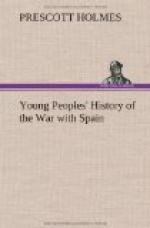San Juan was protected by trenches and forts, and from these places Spanish bullets rained down upon our men. During the early hours of the morning there was much confusion among our troops. They were looking for further orders from headquarters, but none came. So, at last, the captains and colonels took things into their own hands and did what seemed best. Again there was need of more heavy cannon, and again our men were troubled by having powder that made a thick black smoke. Just as it was at El Caney, so it was at San Juan; not having cannon enough to destroy the forts, our men had to take the place by storm. Colonel Roosevelt led his “Rough Riders” in one of the finest charges ever made. The other troops, nearly all “Regulars,” did noble work. With bullets pouring down upon them, our men made a wild rush up the heights, and the Spaniards fled. The struggle to take San Juan had lasted more than five hours, and cost many lives.
Though our men were worn and weary, they took no rest that night. They buried the dead, they repaired the forts and trenches. Our men knew that the Spaniards would try to win back the heights of San Juan, the last stronghold on the outskirts of Santiago.
At daybreak the next morning the Spaniards attacked our troops, and the fighting went on all day. A sharp attack was made in the evening, but our men still held the place. Yet they did not feel secure. The Spanish Army in Santiago was a large one, and might force our men back. Our men, though weary from marching and fighting and digging, hungry, for food was scarce, wanted to hold the heights that had been so dearly won.
The attack upon the Spanish defenses of Santiago began early in the morning of July 1st, as I have told you, and I wish I could tell you the one hundredth part of the brave and gallant deeds that were done by our brave soldiers on that and the next day.
[Illustration: Lieutenant John H. Parker.]
Battery A, of the Second United States Artillery, fired the first shot of the engagement known as the battle of El Caney. The Spaniards replied, after it had sent five shells among them. The Spanish forces were much stronger than our men thought they were, and it took General Lawton nearly all day to gain possession of El Caney. Early in the day, Lieutenant Parker’s battery of four Gatling guns began to hurl bullets into the Spanish trenches, and so well did it keep up the work that it played a very important part in the battle and a great deal of the credit of the victory is due to Lieutenant Parker. Afterwards, Lieutenant Parker, in speaking of these wonderful machine guns, said:
“We trained the guns on the top of the hill. They were fired above the heads of the slowly advancing line of blue which had started up the slope. I ordered the men to work the Gatlings as fast as they could. The result was astounding. With each of the four guns firing at the rate of eight hundred shots a minute, the bullets formed a canopy over the heads of the men at the foot of the hill. A Gatling gun in action is a sight to remember; so thick and fast do the bullets fly that one can actually see the stream of lead leaving the gun and, as if handling a hose, train it on any desired point.




